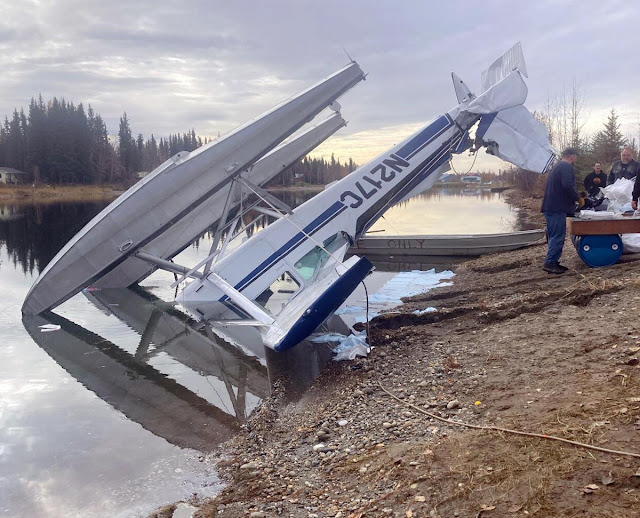Aircraft crashed under unknown circumstances.
Date: 05-OCT-22
Time: 23:53:00Z
Regis#: N217C
Aircraft Make: CESSNA
Aircraft Model: 185
Event Type: ACCIDENT
Highest Injury: FATAL
Total Fatal: 1
Flight Crew: 1 Fatal
Pax: 0
Aircraft Missing: No
Damage: DESTROYED
Activity: PERSONAL
Flight Phase: UNKNOWN (UNK)
Operation: 91
City: FAIRBANKS
State: ALASKA
Those who may have information that might be relevant to the National Transportation Safety Board (NTSB) investigation may contact them by email witness@ntsb.gov, and any friends and family who want to contact investigators about the accident should email assistance@ntsb.gov. You can also call the NTSB Response Operations Center at 844-373-9922 or 202-314-6290.
Jerald Stansel was the owner of a longtime Brooks Range wilderness guiding business, and led clients into what’s now Gates of the Arctic National Park and Preserve starting in the 1970s.
Stansel was piloting a float-equipped Cessna 185 at the Chena Marina airstrip in west Fairbanks on Wednesday afternoon when the crash occurred, according to Clint Johnson, Alaska chief for the National Transportation Safety Board.
Witnesses in the area said the plane flipped over forward while taxiing at slow speed, Alaska State Troopers said in an online report.
Troopers reported a plane upside down in the float pond at the marina, Johnson said.
“Our understanding is there was an attempted take-off that was aborted,” he said. “That’s where the plane rolled slightly to one side, nosed over and then became partially submerged.”
Stansel was extricated from the submerged plane and taken to the hospital, where he was pronounced dead, troopers said.
An NTSB investigator flew to Fairbanks on Thursday.
Stansel ran his guiding business, Alaska Fish & Trails Unlimited, for 40 years, according to the company website. It was up for sale. Stansel, a Vietnam veteran, said he was ready to retire. He told the Fairbanks Daily News-Miner in December that he wanted to spend more time with his children, grandchildren and great-grandchildren.



















I never fly in float planes. Seems to me like keeping the door(s) unlatched during taxi is a good idea. Any reason not to do this?
ReplyDeleteLooking at the picture, it seems the pilot likely drowned while trying to get out of the floatplane which would have been at least partially submerged. If you suddenly find yourself inverted in a small space, filling up with water, and still (presumably) buckled in, it is no easy task to get out of your seat and orient yourself to the door so as to reach the surface. All the while unable to breathe. The FAA has a simulator that allows practice in a swimming pool and various schools will train pilots for this emergency.
ReplyDeleteCabin doors in Cessna floatplanes can help in surface maneuvers (sailing) by allowing the wind to “steer” the aircraft as it floats. It wouldn’t hurt to keep the doors adjacent while on the surface to enhance quicker exit, but don’t forget to close them before takeoff.
Incidentally, I am 76 and former floatplane pilot. In good shape, thankfully, but I’d be really challenged at my age to get out of a Cessna that is under water. RIP
Put his gear down in the water and that's what made it flip.
ReplyDeleteThis a floatplane no gear !
DeleteIf he put the gear down, why is it in the up position ?
ReplyDeleteThis aircraft didn’t have amphibious floats so no gear to be put down.
ReplyDeleteWhat I’m thinking is that after he rejected his takeoff and the aircraft started its settling back on the water, he possibly had his nose down position which allowed the front of the floats to dig deeper into the water thus causing the aircraft to flip over. Example is if your in a boat, the boat is on step but you suddenly power back, the front of the boat will go deeper into the water as the wake the boat caused catches up with the boat and it then pushes the bow downwards. Nothing wrong being done it’s just the effects caused by the wave catching up to you.
Another possibility is that when he powered back he wasn’t in a level flight condition and this caused one float to settle back onto the water before the other float. This puts all the aircrafts weight on the one float until the other float settles onto the water. Bit saying this while taking off you have to break the suction from the water by lifting one float up just enough to allow the other float to break free from the water and this allows the plane to fly. Flying on floats is a very tricky type of flying as with flying on skis. Some pilots aren’t able to catch on to the different flying conditions until after many takeoffs and landings. Again just a unique type of flying. We Alaskans fly many different types of landing gear depending on the season. Of course it’s not just Alaskan flying, many other states/cites are the same.
I’m not meaning any argument or anything with you Mr anonymous but rather just trying to help you with the landing gear phrase. A side note, you can tell amphibious floats verses floats by seeing wheels just barely sticking out from the bottom of the floats when in the retracted position. These types of floats allow you to land on water or paved/solid surfaces. Much more costly then regular floats but then again anything aviation is expensive!! Haha